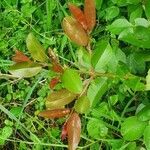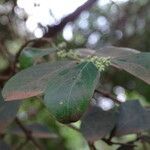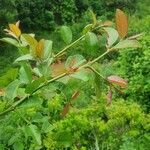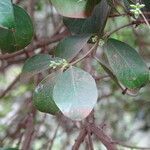Shrubs or rarely small trees 2–5(–10) m. tall, usually scandent.. Bole to 3 dm. thick; older trunks with thick dark corky longitudinally cracked bark; younger herbage and young inflorescences puberulent; branchlets angular, usually emerging at right-angles, numerous.. Thorns prickle-like, recurveds axillary, solitary (but often 2 per node), 2–10(–15) mm. long.. Leaf-blade, ovate to obovate, 2–6 cm. long, 15–40 mm. wide, at base rounded to cuneate, at apex (rarely slightly acuminate to) rounded (sometimes apiculate) or refuse or emarginate, always mucronulate, entire or in the distal two-thirds with a few (up to 9 on each side) indistinct crenulations or appressed teeth, on each side of midrib with 5–8 obscure secondary nerves; petioles 3–10 mm. long.. Stipules 2–3 mm. long, quickly deciduous.. Cymes often fascicle-like, 2–20-flowered (never more than 1 flower per cyme maturing fruit); peduncles 2–7 mm. long; pedicels l–2(–3) mm. long in flower, 2–3 mm. in fruit.. Sepals 1.2–2 mm. long.. Petals 0.7–1 mm. long.. Drupe 7–9 mm. long and thick, pallid when very young, ripening through red to purplish black; endocarps ± 6 mm. long, readily separating into 2(–3) free indehiscent stones.. Fig. 7.
A shrub, small tree or climber. As a tree is grows to 6 m high. It usually has many stems. The trunk is rough with corky bark. The branches are slender. The twigs are smooth. The branches have small, strong, curved thorns in the axils of leaves. The leaves are smooth, shiny and leathery. They are nearly opposite one another. They are often 1-2.5 cm long but can be 7 cm long. They vary from oblong to egg shaped and the tips can be rounded or pointed. The edges of the leaves are often rolled backwards. There are 5-8 pairs of secondary veins. The leaves are shiny on top and duller below. They have short stalks. The flowers are small and greenish-white. They have a sweet scent. They occur in small short bunches in the axils of leaves. The fruit are egg shaped and very small (0.5 cm). The fruit are green when young and turn red or black when ripe. They have a thin layer of flesh and 2 stones. The fruit are edible.
Scandent shrub or liana, 1-8 m high; unarmed or with straight or recurved axillary thorns. Leaves opposite or subopposite, shortly petioled, entire or toothed; stipules minute, deciduous. Flowers in simple, axillary umbels, yellowish green; pedicels slightly longer than petioles. Calyx 5-lobed, somewhat fleshy; tube ± urceolate. Petals 5, shorter than calyx, shortly clawed. Disc inconspicuous, lining calyx tube. Stamens 5, subequalling petals. Ovary superior. Fruit a ± ovoid drupe, dry or somewhat fleshy, black. Seeds usually solitary.
Leaves opposite or subopposite; lamina very variable in size and shape, 2–6 × 1·5–4 cm., ovate or elliptic, apex acute to rounded or retuse, apiculate, margin entire to crenate, base rounded to cuneate, penninerved with 5–8 secondary nerves on either side of the midrib, discolorous in dry state, glabrous; petiole 3–10 mm. long, glabrous or puberulous.
Shrub or tree, usually somewhat scandent, up to 4 m high, armed with axillary spines. Leaves penninerved, lamina ovate or elliptic, apex acute to rounded orretuse, apiculate. Fruit obovoid to spherical, up to 8 mm in diameter, glabrous. Flowers green.
Armed, scandent shrub or small tree to 8 m, with straight or recurved, axillary thorns. Leaves usually opposite, ovate, leathery, glossy above. Flowers in axillary umbels, yellowish green. Fruits thinly fleshy, black.
Flowers sessile or with pedicels 1–2 mm. long; bracts up to 1 mm. long, deltate, ciliate, glabrous or minutely tomentose.
Shrub or tree, usually somewhat scandent; branchlets glabrous or sparingly puberulous.
Flower-bud glabrous or minutely tomentose, sometimes puberulous only at apex.
Petals 1 mm. long, deeply 2-lobed at apex, shortly unguiculate.
Fruit obovoid to spherical, up to 8 mm. in diam., glabrous.
Stamens with short filaments, slightly swollen at the base.
Ovary 2-locular; style very short, obscurely 2-lobed.
Prickles up to 9 mm. long, recurved, in leaf-axils.
Cymes condensed; peduncle up to 7 mm. long.
Seed pale, 6 × 6 × 1·5 mm., plano-convex.
Sepals 1·5–2 mm. long, deltate.
Disk not lobed.





